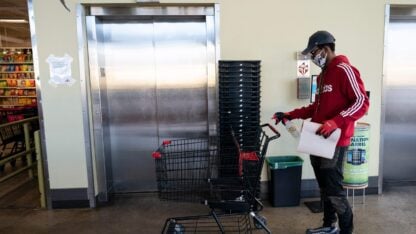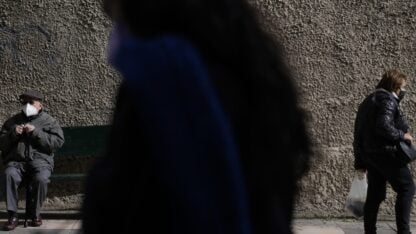Coronavirus Update: Georgia Infections Top 50K; Tear Gas Use Worries Emory Expert

Demonstrators, who had gathered to protest the death of George Floyd, begin to run Monday from tear gas used by police to clear the street near the White House in Washington, D.C. Tear gas had been used in some protests in Atlanta. Tear gas and other chemical agents cause people to rub their eyes, putting demonstrators at risk of the coronavirus, Dr. Jay Varkey said.
Evan Vucci / Associated Press
Police could be spreading the coronavirus by spraying tear gas on demonstrators, an Emory University infectious disease specialist said Friday as the number of confirmed infections in Georgia surpassed 50,000.
Mass arrests and confining people in small spaces also dramatically increase the risk of infecting others with the coronavirus, Dr. Jay Varkey said Friday.
Tear gas and other chemical agents cause people to rub their eyes, putting demonstrators at risk of being infected, Varkey said.
Thursday was the second straight night police refrained from using tear gas to clear protesters from downtown Atlanta at curfew. But it had been used during previous protests.
“When I see the wide use of things like tear gas or pepper bombs that by its nature cause people to immediately rub their eyes, that causes me tremendous consternation in terms of the risk of what that could cause in terms of infection transmission during a pandemic,” Varkey said.
“From a public health standpoint, I don’t know whether law enforcement is actively looking at agents other than tear gas or pepper bombs,” he said. “As a physician, do I think they should? Yes, absolutely.”
The Georgia Department of Public Health reported Friday afternoon that Georgia has confirmed more than 50,600 total coronavirus infections since the first cases were reported March 2. The virus has been blamed for at least 2,174 deaths statewide as of 3 p.m. Friday.
COVID-19 infections and deaths have more than doubled in Georgia since late April when the state began relaxing restrictions and allowing shuttered businesses to reopen. Experts say some of the rise in total cases is likely because of increased testing.
Varkey and Emory professor Hank Klibanoff, who studies topics related to racism, offered their perspective on the virus and the nationwide protests over police misconduct during a Friday news briefing.
Demonstrators must make a personal decision about whether to protest, weigh the risks involved, and take steps to protect themselves and others from the virus, Varkey said.
But he said that safety during demonstrations “can’t be one-sided.”
“It’s important to acknowledge that municipalities and law enforcement have an equal responsibly to guide their actions during a pandemic.”
Though cases have reached a plateau in much of the nation, they are still increasing in more than a dozen states, he noted.
Varkey said that data clearly shows that minorities are at a higher risk of COVID-19, the disease spread by the virus. Racism is also a concern among public health experts, he said.
“Although COVID-19 is a major public health threat, it would be disingenuous not to recognize that structural racism is also a major public health threat.”
For most people, the virus causes mild or moderate symptoms. For some, especially older adults and people with existing health problems, it can cause more severe illness, including pneumonia, and death.








